Matterhorn Cervino - World Cup Key Locations For The "Gran Becca" Revealed

Fewer than 100 days remain until the first cross-border race in the history of the Alpine Skiing World Cup: the "Matterhorn Cervino Speed Opening".
On 29th - 30th October and 5th - 6th November 2022, Alpine skiers will be able to compete for the first time in the speed season opener in Zermatt/Cervinia. In addition to the novelty of the two nations, the organisers want to set themselves apart with several additional innovations.
A new feature for visitors is that at the finish, almost two thirds of the run will be visible, as well as the border crossing. The first part of the race, from the start between the mountain stations of the two Rosa Plateau teleskis to the Italian border, can be seen from the ski run. In addition, at Testa Grigia, a public viewing area is provided. On the Italian side, the races can be followed from the finish area.
"Gran Becca" takes shape
The names of the key sites of the "Gran Becca" have been revealed. They reflect the nature and the landscape. The three jumps are called "Matterhorn", "Furggen" and "Cime Bianche". Other key locations are "Sérac Traverse" towards the border, "Muro Ventina", "Spalla di Rollin" and "Plateau Rosa Schuss". A new feature awaits the athletes participating in the "Matterhorn Cervino Speed Opening" at the start.
For the first time in the history of the Alpine Skiing World Cup, a start hut with a photovoltaic system is being built. It consists of a light-weight, petroleum-free pneumatic casing. The start hut can be assembled or dismantled in just a few hours and is only used temporarily.
Meeting the logistical challenges
In particular, the winter with little snow and the high temperatures of the last few months have also left their mark on the Theodul Glacier. The Zermatt summer ski area is open and the ski teams are currently finding excellent training conditions. On the Swiss side, half of the «Gran Becca» is already prepared for racing and can be used for training purposes. The work on the glacier, both the traverse to the border and the Italian part, will continue in the coming weeks. For the lower part of the route, which is not on the glacier, there are snow depots with mostly natural snow. In addition, this section can be snowed with artificial snow in a maximum of 72 hours at sub-zero temperatures. "We need three to four cold nights and natural snowfall on the glacier by mid-October," predicts OC President Franz Julen. «Weather scenarios that are quite realistic in autumn at altitudes of over 3,000 meters. We are confident that the first "Matterhorn Cervino Speed Openings" will go ahead as planned, knowing full well that nature and the weather have the last word in outdoor sports."
Now the names of the key points of the «Gran Becca» are also known. These should reflect nature and the environment. The three jumps are called "Matterhorn", "Furggen" and "Cime Bianche". Other key points are the "Sérac Traverse" towards national borders, the "Muro Ventina", the "Spalla di Rollin" and the "Plateau Rosa Schuss". Another innovation awaits the participating athletes at the "Matterhorn Cervino Speed Opening" right from the start. For the first time in the history of the Alpine Ski World Cup, a start house with a photovoltaic system is being built. This consists of a light, pneumatic shell, which is produced without the use of petroleum. The start house can be set up and taken down within a few hours and is only used temporarily.
Master logistical challenges
Since the race track and in particular the finish area, unlike most races on the World Cup calendar, are more than 1,000 meters above the villages of Zermatt and Cervinia, a logistical masterpiece by the organizers is required. In order to do justice to both venues, it was decided that the men's teams would stay in Zermatt and the women's teams in Cervinia. The bib number draw and prize giving will take place on Friday and Saturday evenings in Zermatt and Cervinia, with the event taking place in Zermatt on the first weekend, with live transmission in Cervinia and vice versa on the second weekend.
The Swiss Radio and Television Company (SRG), headed by Beat Zumstein (producer) and Beni Giger (director), is responsible for the TV production of the World Cup spectacle on the Matterhorn. All alpine ski competitions at the Olympic Games since Turin 2006 have been successfully produced by this duo. The international sports marketing company Infront Sports & Media will take care of the international distribution of the TV signal and thus the greatest possible media coverage.
Despite the tight schedule, the organizing committee for the «Matterhorn Cervino Speed Opening» remains optimistic saying "We are on course with the preparatory work. The responsibilities and tasks are spread over several shoulders, the cooperation between the stakeholders, especially with the two national ski associations Swiss-Ski and FISI, works optimally; everyone involved is motivated and enthusiastic about their work,"
OC President Franz Julen added "Four successful FIS inspections have already taken place. The FIS is very satisfied with the status of the preparations, suggestions for improvement are now being implemented accordingly."
Since the race route and especially the finish area are, unlike most other races on the World Cup calendar, more than 1,000 metres above the villages of Zermatt and Cervinia, the organisers' logistical skills must be perfect. In order not to give any of the event's destinations an advantage, it was decided that the men's teams would sleep in Zermatt and the women's teams in Cervinia. The drawing of the race numbers and the distribution of the prizes will take place on Friday and Saturday evenings in Zermatt and Cervinia respectively. On the first weekend, everything will take place in Zermatt, with live broadcasting in Cervinia, and on the second weekend, it will be the opposite.













